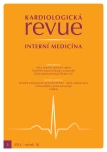Nursing care standardization for sheath removal at interventional centres in the Czech Republic
Authors:
L. Klemsová 1,2; K. Žiaková 3
Authors‘ workplace:
Ústav ošetřovatelství a porodní asistence, LF OU v Ostravě
1; Kardiovaskulární oddělení, FN Ostrava
2; Ústav ošetrovateľstva, JLF Martin a UK Bratislava, Slovensko
3
Published in:
Kardiol Rev Int Med 2014, 16(3): 191-195
Category:
Cardiology Review
Overview
Aim:
The analysis of special nursing care focusing on arterial sheath removal at interventional sites in the Czech Republic.
Methods:
The empirical data was collected by means of a questionnaire created by us for the purposes of this article. The questionnaire consisted of seven questions (six closed, dichotomous; one open). According to the National Register of Cardiovascular Interventions (NRKI) of the Czech Republic, there are 22 centres performing cardiovascular interventions. All of them were approached with a request to fill in the questionnaire. The questionnaire was distributed through official e‑mail addresses. The results for each monitored item were put into a chart showing absolute frequency.
Results:
The analysis showed that the most common approach in the Czech Republic is via radial artery, in up to 78% of cases. Sheath decannulation from the arterial basin is performed by nurses at 16 centres, 10 of which have implemented the specialised nursing standard. Nurse training for professional performance takes place at four centres only, which is disproportionate to the number of decannulations carried out by nurses.
Conclusion:
The introduction of the nursing standard for sheath removal is not a condition for a nurse to perform it, despite the fact that it is carried out quite routinely at 16 centres. According to the data obtained, the management of sheath decannulation in the Czech Republic is very disunited.
Keywords:
nursing standard – decannulation – sheath – femoral – radial
Sources
1. Smith TT, Labrilola R. Developing best practice in arterial sheath removal for registered nurses. J Nurs Care Qual 2001; 16 : 61 – 67.
2. Tagney J, Lackie D. Bed ‑ rest post‑femoral arterial sheath removal – what is safe practice? A clinical audit. Nurs Crit Care 2005; 10 : 167 – 173. doi: 10.1111/ j.1362 ‑ 1017. 2005.00121. x.
3. Bernat I, Brtko M, Horák D. Současný stav a perspektivy radiálního přístupu v české intervenční kardiologii – nastal čas pro intenzivnější výměnu zkušeností? Interv Akut Kardiol 2007; 6 : 113 – 114.
4. Goldshtein L, Rassin M, Cohen I et al. Managing pseudoaneurysm after cardiac catheterization. Nursing 2006; 36 : 64.
5. Dumont CJ, Keeling AW, Bourguignon C et al. Predictors of vascular complications post diagnostic cardiac catheterization and percutaneous coronary interventions. Dimens Crit Care Nurs 2006; 25 : 137 – 142.
6. Hamon M, Coutance G. Transradial intervention for minimizing bleeding complications in percutaneous coronary intervention. Am J Cardiol 2009; 104 : 55 – 59. doi: 10.1016/ j.amjcard.2009.06.023.
7. Ierna S, Belli R, Giammaria M et al. Successful angioplasty and stenting of bilateral internal mammary artery grafts from the left radial approach. Case report and review of the literature. J Cardiovasc Med 2007; 8 : 531 – 534. 10.2459/ 01.JCM.0000278441.74117.b7.
8. Agostoni P, Guiseppe BZ, Benedictis LD et al. Radial vs femoral approach for percutaneous coronary diagnostic and interventional procedures; Systematic overview and meta‑analysis of randomised trials. J Am Coll Cardiol 2004; 44 : 349 – 356. doi.org/ 10.1016/ j.jacc.2004.04.034.
9. Gall S, Tarique A, Natarajan A et al. Rapid ambulation after coronary angiogramy via femoral artery access: a prospective study of 1,000 patients. J Invasive Cardiol 2006; 18 : 106 – 108.
10. Hulková V. Štandardy v ošetrovateľstve. Martin: Osveta 2005 : 10 – 12.
11. Shoulders ‑ Odom O. Management of patients after percutaneous coronary interventions. Crit Care Nurse 2008; 28 : 26 – 41.
12. Leeper B. Nursing outcomes: percutaneous coronary interventions. J Cardiovasc Nurs 2004; 19 : 346 – 353.
13. Liew R, Lidder E, Gorman E et al. Very low complication rates with a manual, nurse ‑ led protocol for femoral sheath removal following coronary angiography. Eur J Cardiovasc Nurs 2007; 6 : 303 – 307. doi: 10.1016/ j.ejcnurse.2007.03.001.
14. Schiks I, Schoonhoven L, Verheugt F et al. Performance evaluation of arterial femoral sheath removal by registered nurses after PCI. 2007. Eur J Cardiovasc Nurs 2007; 6 : 172 – 177.
15. Hamon M, Filipi ‑ Codaccioni E, Riddel JW et al. Prognostic impact of major bleeding in patients with acute coronary syndromes. A systematic review and meta‑analysis. EuroIntervention 2007; 3 : 400 – 408.
16. Walker SB, Clary S, Higins M. Comparison of the FemoStop device and manual pressure in reducing groin puncture site complications following coronary angioplasty and coronary stent placement. Int J Nurs Pract 2001; 7 : 366 – 375.
17. Rathore S, Stables RH, Pauriah M et al. A randomized comparison of TR band and radistop hemostatic compression devices after transradial coronary intervention. Catheter Cardiovasc Interv 2010; 76 : 660 – 667. doi: 10.1002/ ccd.22615.
Labels
Paediatric cardiology Internal medicine Cardiac surgery CardiologyArticle was published in
Cardiology Review

2014 Issue 3
Most read in this issue
- Diverticular disease of the colon – new trends in therapy
- Irritable bowel syndrome – diagnosis and treatment
- Chronic pancreatitis
- Proton pump inhibitor treatment
